An Extensive Guide to Bathroom Terminology
Welcome to our latest blog post, “An Extensive Guide to Bathroom Terminology“. Whether you’re a first-time homeowner, a seasoned DIY enthusiast, or someone simply looking to update their bathroom, understanding the terminology used in bathrooms and plumbing can feel like learning a new language. From Vanity Units to Waterfall Taps, back-to-wall units to P units – the list goes on, and it can undoubtedly be overwhelming. But worry no more! Showers to You have compiled this comprehensive glossary to guide you through the jargon, enabling you to make informed decisions about your bathroom design and plumbing needs. So, let’s dive in and demystify these terms together!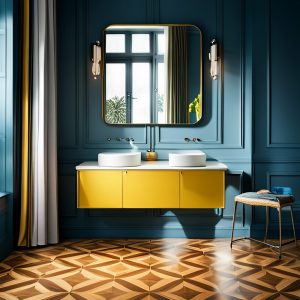
Basins:
Basin: A bowl-shaped fixture used for washing hands, face and often for dishwashing.
Ceramic: A hard, brittle, heat-resistant and corrosion-resistant material made by shaping and then firing a non-metallic mineral, such as clay, at a high temperature, often used to manufacture sanitary ware, including basins.
Cloakroom Basin: A compact basin designed for small spaces like cloakrooms or powder rooms.
Countertop Basin: A basin/ vessel basin that sits on a counter or vanity unit.
Overflow: A feature in a basin that prevents water from spilling over the basin’s edge is left unattended while filling. A small hole near the top of the basin drains excess water.
Pedestal Basin: A basin that is supported by a pedestal stand.
Pedestal: A column or stand that supports a basin and conceals any plumbing pipes.
Pre-drilled: Refers to basins that come with pre-drilled holes for tap installation. The number of holes can vary, but they typically come in one-hole or three-hole varieties.
Sanitaryware: The general term for items and fixtures in the bathroom, including basins, toilets, bidets, etc.
Semi-Recessed Basin: A basin design where the back half is recessed into a countertop or unit while the front half protrudes outwards.
Under Counter Basin: A basin is installed under the countertop, creating a seamless look and making cleaning easier.
Vitreous China: A ceramic material glazed with enamel for increased durability, stain resistance, and shine.
Wall Hung Basin: A type of basin mounted directly onto the wall, freeing up floor space and creating a clean, minimalist look.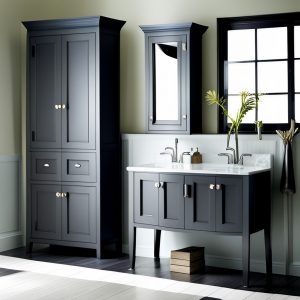
Bathroom Furniture:
Back-to-Wall Units: Bathroom units are designed to sit flush against a wall, often housing the toilet cistern or providing additional storage.
Bathroom Furniture Packs: Pre-selected sets of bathroom furniture designed to complement each other and provide a cohesive look.
Cloakroom Furniture: Compact furniture explicitly designed for small bathrooms or cloakrooms, often combining several functions into one piece to save space.
Combination Unit: A multifunctional piece of bathroom furniture that combines several features, such as a basin, toilet, and storage.
P Unit: A compact bathroom that combines a sink and toilet into one piece, saving space and often used in smaller bathrooms or ensuites.
Tallboy Storage Units: A tall, narrow piece of furniture with multiple shelves or drawers for storing items in a bathroom.
Vanity Units: A piece of bathroom furniture that combines a basin and storage, typically used to store toiletries and other hygiene products.
Wall Hung Basin Units: A type of unit mounted directly onto the wall with a built-in basin, often including storage underneath and freeing up floor space.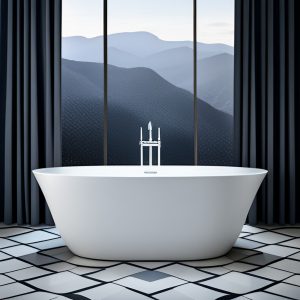
Bathtubs:
Acrylic Bath: Bathtubs that are made from acrylic, a material that’s warm to the touch, lightweight, and available in many designs.
Bath Grips: Handles attached to the bath to provide support when getting in or out.
Bath Legs: Legs that support the bathtub, often adjustable for levelling.
Bath Panel: A board used to cover the underside of a bathtub.
Bath Plinth: A platform that raises the bath off the floor, often used with freestanding baths.
Bath Rack: A rack that fits across the bath, providing a place to hold items such as soap, sponges, or books.
Bath Screen: A glass panel that prevents water from splashing out of the bath during a shower.
Bath Seal: A waterproof sealant used to avoid water leakage around the bath.
Bath/ Bathtub: A large container for holding water where a person may bathe.
Corner Bath: A bath designed to fit into a corner of the bathroom, often larger and more profound than standard tubs
Double Ended: A bath with taps and waste in the middle so you can bathe at either end.
Freestanding: A bathtub that stands alone and is not attached to any walls.
Jacuzzi Bath: A bath with jets that circulate water, providing a massage effect.
Offset Bath: A bath with one end wider than the other, providing more space for showering.
Roll Top Bath: A traditional freestanding bath style with rollover edges.
Shower Bath: A combination of a bath and shower, often with a broader end for showering.
Single Ended: A bath where the taps and waste are at one end, allowing for bathing at the other end.
Slipper Bath: A freestanding bathtub with one or both ends sloping upwards for added comfort.
Steel Bath: A bathtub made from steel, known for its durability and heat retention.
Walk-In Bath: A bath with a door in the side, allowing for easy access without stepping over the side.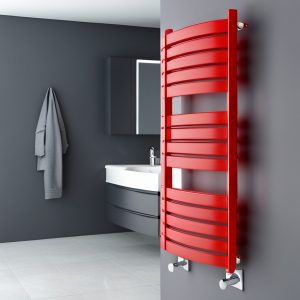
Heating:
Bar: The pressure at which a system operates. One bar is the force used to push water 10 metres.
BS EN 442: A British and European standard that specifies the testing and rating requirements for radiators and convectors
BTU: British Thermal Unit is a unit of heat energy used in the heating and cooling industry
Central Heating: A system that provides heat to an entire building from one source, typically a boiler.
Colosseum Radiators: A type of radiator with a distinctive multi-column design, often used for their high heat output and classic appearance.
Column Radiators: Traditional radiators comprise vertical columns through which hot water flows to heat the room.
Compact Radiators: Smaller radiators designed for use in rooms with limited wall space.
Curved Heated Towel Rail: A heated towel rail with curved horizontal bars.
Dual Fuel: A heating system that can run on two fuel types.
Electric: In this context, it refers to electricity-powered radiators or heating systems.
Heated Towel Rail: A radiator designed to dry towels and heat the bathroom.
Pipe Centres: The distance between the centres of the two pipes that feed a radiator.
Radiator Bleed Valve: A small valve releases air trapped in a radiator.
Radiator Valve: Controls the flow of hot water to the radiator. They can be manual or thermostatic.
Radiator: A device that emits heat into the surrounding area.
Straight Heated Towel Rail: A heated towel rail with straight horizontal bars.
Towel Radiator: Another term for a heated towel rail.
Towel Warmer: A type of heated towel rail that not only dries towels but also warms them.
Underfloor Heating: A modern, high-efficiency heating system installed beneath the floor surface. It provides even and comfortable radiant heat throughout the room, eliminating cold spots and reducing energy consumption.
Wall Distance: The distance from the wall to the front face of the radiator.
Wall-to-Pipe Centres: The distance from the wall to the centre of the pipes that feed a radiator.
Watts: The power output of a radiator, measured in watts. The higher the wattage, the more heat the radiator can produce.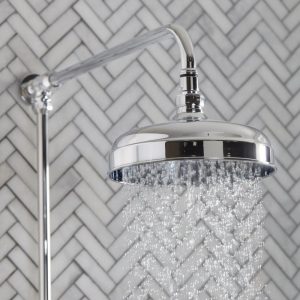
Showers:
Body Jets: Shower fixtures are installed in the walls of a shower to provide streams of water from multiple angles.
Check Valve: A type of valve that allows fluids to flow in one direction but closes automatically to prevent flow in the opposite direction.
Concealed Valve: A shower valve where all plumbing connections and the valve body are hidden behind the wall, with only the control plate and handle visible. This offers a sleek, streamlined look in the bathroom.
Digital Shower: A shower system controlled by a digital interface, allowing precise control of temperature, pressure, and often programmed settings.
Diverter: A valve in a shower system that redirects water flow from one outlet to another, such as from a faucet to a showerhead.
Dual Function Shower: A shower system that provides two distinct functions or modes of operation. This could include combinations like a standard overhead shower, handheld showerhead, or two different spray patterns.
Electric Shower: A shower that heats water instantly as it flows through the unit, eliminating the need for a separate hot water tank.
Exposed Valve: A shower valve where the entire valve body, including plumbing connections, is mounted on the wall’s surface, making it fully visible.
Flow Rate: The speed at which water flows from a shower or faucet, typically measured in gallons per minute (GPM).
Gravity Pump Shower: A type of shower system that relies on gravity to feed water from a tank usually located in the loft of a house.
Handheld Shower/ Handset: A detachable showerhead that can be held in hand for more directed water flow.
KW Rating: A measure of electrical power with higher ratings indicating greater power and faster heating.
Manual Shower Mixer: A device in a shower that mixes hot and cold water, controlled manually by the user.
Phased Shut Down: A safety feature in electric showers that flushes hot water out of the system when turned off to prevent scalding when it’s next used.
Power Shower: A shower that uses a pump to increase water pressure, providing a more vigorous shower experience.
Riser Rail: A vertical bar in a shower enclosure that holds and adjusts the height of the showerhead.
Rough In Valve: The part of a shower valve installed in the wall before the finished wall surface is applied.
Shower Arm: The pipe fitting extends from the wall and connects to the showerhead.
Shower Hose: The flexible tubing that connects a handheld showerhead to the water source.
Shower Trim: The visible parts of a shower fixture, such as handles, plates, and the showerhead.
Showerhead: A device disperses water in a shower, often adjustable to produce a spray or stream of varying patterns and intensities.
Single Function Shower: A shower system that offers one function or mode of operation, typically a single spray pattern from the showerhead.
Slide Rail: Another term for a riser rail.
Stop Cock: A type of valve completely stops water flow through a pipe.
Thermostatic Mixer Shower: A shower system that automatically mixes hot and cold water to a pre-set temperature, maintaining it even when other water sources are used.
Thermostatic Valve: A valve that automatically adjusts the water’s temperature to a pre-set level.
Triple Function Shower: A shower system that offers three separate functions or modes of operation. This could be a combination of an overhead shower, a handheld showerhead, body jets, or three different spray patterns from the showerhead.
Wall Outlet: In a shower, a fitting where the water supply pipe exits the wall and connects to the shower hose.
WRAS Approved: A certification issued by the Water Regulations Advisory Scheme in the UK, indicating that a product complies with high standards of water efficiency and safety.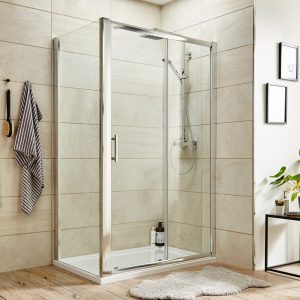
Shower Enclosures:
Adjustment: Refers to the ability to adjust the size of a shower enclosure to fit a specific space.
Anti Slip Shower Tray: A shower tray with a textured surface to prevent slipping.
Bifold: A shower door that folds in the middle to open, saving space.
Corner Shower Tray: A shower tray designed to fit into a corner.
Corner: A shower enclosure designed to fit into a bathroom corner.
D Shape Shower Tray: A shower tray with a curved front and a flat back, shaped like a ‘D’.
End Panel: A panel that forms the end of a shower enclosure or bath.
Hinged: Similar to a pivot door, the hinges are located at the side of the door rather than at the top and bottom.
Inline Panel: A fixed glass panel aligned with the shower door in a shower enclosure.
Offset Quadrant Shower Tray: A tray that fits an offset quadrant shower enclosure.
Offset Quadrant: A type of shower enclosure that fits into a corner but has one side longer than the other, providing more showering space.
Pentagon: A shower enclosure designed to fit into a corner with a five-sided shape.
Pivot: A shower door that swings open like a standard door, pivoting on a hinge.
Quadrant Shower Tray: A shower tray designed to fit a quadrant shower enclosure.
Quadrant: A shower enclosure designed to fit into a corner with a curved front.
Rectangle Shower Tray: A shower tray with a rectangular shape.
Reversible: A shower door or enclosure that can be installed to open from either the left or the right.
Shower Cubicle: Another term for a shower enclosure, often used in the UK.
Shower Door: The entrance to a shower enclosure, which can be sliding, pivoted, hinged, or bifold.
Shower Enclosure: A structure with walls and a door enclosing a bathroom shower area.
Shower Screen: A single panel of glass used to prevent water from splashing out of the shower area.
Shower Tray: The base of a shower enclosure that collects and drains away water.
Side Panel: A fixed panel of glass that forms one of the sides of a shower enclosure.
Sliding Shower: A shower enclosure with a sideways door, typically on tracks.
Square Shower Tray: A shower tray with a square shape.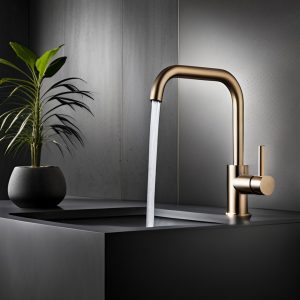
Taps:
Aerator: A device at the end of the tap that mixes air with the water flow to reduce splashing and increase the perceived water pressure.
Basin Mixer: A tap that blends hot and cold water before it exits, allowing for precise temperature control.
Bath Filler: A tap designed to fill a bathtub quickly, often with separate controls for hot and cold water.
Bath Shower Mixer: A type of tap that combines the features of a bath filler and a hand shower.
Bath Taps: General term for taps used in a bathroom can refer to basin taps, bath fillers, or shower mixers.
Brassware: Collective term for fixtures and fittings made from brass, including taps and other bathroom accessories.
Ceramic Disc Technology: A type of tap valve that uses two ceramic discs to control water flow, known for its durability and resistance to drips.
Crosshead Handle: A type of tap handle with a cross shape, typical in traditional or classic bathroom designs.
Deck Mounted: Taps installed on the surface of the basin or bath, as opposed to being wall-mounted.
Faucets: Another term for taps, commonly used in North America.
Flow Regulator: A device used in taps to limit the amount of water flow, helping to conserve water.
Freestanding: Taps that stand independently, not attached to the wall or deck, commonly used with freestanding bathtubs.
High Pressure: Refers to taps designed to work optimally with high-pressure water systems.
High Rise: A tall tap above the basin, typically used with countertop or vessel basins.
Lever Handle: A tap handle that moves a lever up and down or side to side.
Low Pressure: Refers to taps that work best with low-pressure water systems.
Monobloc: A tap with a single body and one or two handles to control water temperature and flow.
Pillar Taps: A pair of individual taps, one for hot water and one for cold water.
Pop-Up Waste: A drain plug that can be opened or closed by pushing it down or up.
Single Hole/ 1TH: A basin or tap design that requires one hole for installation. Typically used with monobloc or single lever taps.
Spout: The part of the tap where water flows out.
Swivel Spout: A tap design where the spout can be rotated from side to side.
Wall Mounted: Taps installed directly into the wall, freeing up counter space and providing a clean, minimalist look.
Waterfall: A tap that delivers water in a wide, flat stream, mimicking a waterfall.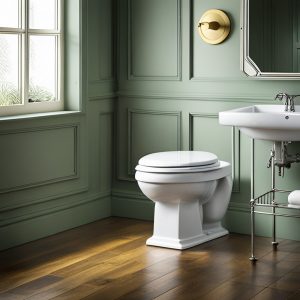
Toilets:
Back to Wall: A type of toilet design where the toilet pan sits flush against the bathroom wall, concealing the cistern and pipes for a cleaner look.
Bidet: A bathroom fixture that replaces the use of toilet paper.
Bowl/ Pan: The part of the toilet collects waste before it is flushed away.
Cistern: The tank on a toilet that holds water for flushing.
Close Coupled: A type of toilet where the cistern is directly attached to the bowl or pan, making it one compact unit.
Comfort Height: A taller toilet design that is easier for people with mobility issues. The height is typically similar to that of a standard chair.
Concealed Cistern: A cistern hidden behind a wall or within a piece of furniture. This design provides a sleek, minimalist look.
Dual Flush: A type of toilet that offers two flush options.
Float Ball: A component in the cistern that rises with the water level and signals when to stop filling.
Flush Valve: The part of a toilet that controls the release of water from the cistern to the bowl when you flush.
Front Access Cistern: A cistern design that allows access to the internal components from the front, making maintenance easier.
High Level: A traditional toilet design where the cistern is mounted high on the wall and connected to the pan by a long pipe.
Low Level: A type of toilet where the cistern is mounted low on the wall and connected to the pan by a short pipe.
Medium Level: Like a low-level toilet, the cistern is mounted higher on the wall.
Overflow Tube: A component in the cistern that prevents water from overflowing if the fill valve fails to shut off.
P-Trap: A type of toilet drain pipe that curves in a P shape to trap water and prevent sewer gases from entering the home.
Pull Chain: A toilet flush mechanism commonly found in older or traditional-style toilets where a chain is pulled to release the water from the cistern.
Rimless Toilet: A toilet design without the traditional rim around the inside of the bowl. This allows water to reach every part of the bowl for a more thorough and hygienic flush.
Syphon: A type of flush mechanism that uses the pressure of the water in the cistern to create a siphoning effect, pulling water from the cistern into the bow.
Touchless/ Contactless Flush: A type of flush system that uses a sensor to activate the flush, reducing the need to touch potentially germ-covered surfaces.
Wall Hung: A type of toilet mounted to the wall, with the cistern concealed. This design frees up floor space and makes cleaning easier.
Wastes: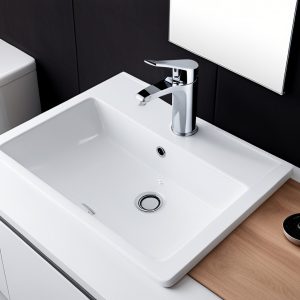
Bath Trap: A type of trap specifically designed for use with bathtubs to prevent sewer gas from coming up through the drain.
Bath Waste: The assembly that controls water drainage from a bathtub. This typically includes a plug, chain, and overflow.
Bottle Trap: A type of trap used in plumbing to prevent sewer gases from entering a home or building.
Chain Waste: A bath waste that uses a chain attached to a plug to stop and release water from the bath.
Flip Waste: A type of drain plug that can be opened or closed by flipping the centre.
P Trap: Similar to an S trap, the bend is shaped like a ‘P‘.
Pop Up: A type of bath waste where the plug is opened and closed by turning a dial or lever.
Push Button: A waste mechanism where a button opens and closes the plug.
S Trap: A trap in which the bend is shaped like an ‘S’ to block sewer gasses.
Slotted: Refers to waste outlets with slots or holes to allow overflow water to drain away.
Unslotted: Refers to waste outlets without a slot, typically used with basins that do not have an integrated overflow.
Waste Pipe: A pipe designed for draining liquid waste or excess liquids. They carry wastewater and sewage away from your basin.
Waste: In plumbing, “waste” refers to water and other substances to be drained from the home.
Why should I shop at Showers to You?
Shopping at Showers to You provides an unparalleled experience for all your bathroom needs. We offer many high-quality products, from stylish shower units to sophisticated heating systems. Our commitment to customer satisfaction goes beyond just offering premium products. Contact one of our experts today via email (info@showerstoyou.co.uk), telephone (01472 242159) or online contact form.